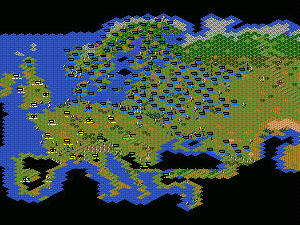Tuesday 13 November 2001

|
Pic of the day: Screenshot from Civ2, severely zoomed out. Sometimes it is a good idea to zoom out, you know, to get the big picture. Only one civilizationThere is no "clash of civilizations", except perhaps when you play one of the Civilization strategy games. In these, civilizations are used as a synonym for nations, and this again hails back to an older board game based on the world around the Mediterranean. In real life (and indeed in Civilization, if you look closer) there is only one civilization. It may not have always been like that. It is possible that the first agricultural boom happened independently several places in the world. Certainly the plants cultivated and the animals domesticated seem to have varied from one part of the world to another. Even so, it is kind of suspicious how they all follow the same recipe: Cultivate local plants, especially grasses with edible grains, domesticate animals for milk and meat and hides, then move together in cities, specialize and trade. Even the tradition of fermenting some sort of alcoholic beverage from part of the food supply seems to be fairly general. It is as if one single person with a lifetime of several hundred years had traveled around the globe, stopping in some of the most convenient locations and taught the local tribes the secret of civilization, then moved on. A more likely explanation is that the rumor has spread. Humans love rumors, and humans love to travel. The basic concepts of civilization are so simple that they could indeed be spread that way. According to the Norwegian explorer and scientist Thor Heyerdahl, it was even possible to sail from Egypt to America in an ancient papyrus boat. He even did so with a small crew, a rather convincing demonstration. And a small crew or even one survivor would be all that was needed to bring the news of a better life. (Disclaimer: It is in no way proved that there has been contact between the ancient civilizations in the Mediterranean and the Americas, just that it was possible. Many distinguished scientists think it highly unlikely. Many distinguished scientists obviously believe that after 4 million years as hominid hunter-gatherers, or at least 100 000 years as modern humans, it was only natural that two or more groups of people came upon basically the same ideas within a couple thousand years of each other, surrounded by completely different plants and animals, speaking a completely different language, and not having seen other humans since sometime during the ice age when the Neanderthals were still alive and well. Being a scientist must be great fun, especially if you get paid for it.) The young civilizations may have grown mostly on their own for a while, but that time is long gone. As agriculture led to a population boom, civilizations spread until they met and mingled. India had contacts both to China and to the Mediterranean, and traded both goods and information both ways. Our current mathematics based on the decimal system were made available by the Indian concept of zero and the Arabic numerals. The circle of 360 degrees came from ancient Sumer. Gunpowder, compass and the printing press came from China. Later other ideas have been exported the other way. The native American cultures may not have given us much in terms of inventions, but they gave us maize (corn in US English) and potatoes, tobacco (sorry about that) and not least the wonderful gift of chocolate. Today, information and goods flow freely from continent to continent. There may certainly be different traditions, but there is only one civilization. There is no going back. Some confused people may think that there is still time to turn the calendar back at least to the middle ages. No. Time is a one way road. We will not see a "clash of civilizations". We do see the occasional barbarian attack, but this time the barbarians have chosen to be what they are. |
Another sunny day! |
Yesterday <-- This month --> Tomorrow?
One year ago
Two years ago
Three years ago